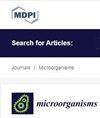阴道微生物组:患者与医生采集的微生物拭子对比:试点研究
IF 4.1
2区 生物学
Q2 MICROBIOLOGY
引用次数: 0
摘要
试管婴儿/试管婴儿-卵胞浆内单精子显微注射(IVF/IVF-ICSI)治疗前的阴道微生物群组成可以预测怀孕的几率。为了提高临床适用性并方便患者,最好能自行采集阴道样本。然而,与医生采集样本相比,患者采集样本的可靠性仍不明确。本研究比较了患者采集和医生采集阴道样本的微生物组结果。这是一项由两个队列组成的前瞻性试验研究:队列 I 先由患者自行采集阴道样本,然后由医生采集阴道拭子,而队列 II 的采集顺序则相反。所有样本中的微生物群组成均采用间距剖析(IS-Pro)技术进行分析。从 2021 年 5 月到 2022 年 3 月,共收集了 n = 222 名患者(21-44 岁)的 444 份样本,其中队列 I(n = 109)和队列 II(n = 113)。无论采样顺序如何,两组患者的阴道微生物组组成高度相似,组群 I 的平均余弦相似度为 0.93(95% CI 0.91,0.95),组群 II 的平均余弦相似度为 0.94(95% CI 0.92,0.96)。此外,方差分析显示,医生采集的样本和患者采集的样本之间,以及第一次和第二次采集的样本之间,细菌种类丰富度没有明显差异。自我采集的阴道样本与医生采集的样本具有可比性,表明在门诊临床环境中采集阴道微生物组更方便患者。本文章由计算机程序翻译,如有差异,请以英文原文为准。
The Vaginal Microbiome: Patient- versus Physician-Collected Microbial Swab: A Pilot Study
The composition of the vaginal microbiota prior to an IVF/IVF-ICSI treatment can predict the chance of achieving a pregnancy. To improve clinical applicability and be more patient-friendly, the self-collection of vaginal samples would be preferable. However, the reliability of patient-collected samples compared to physician-collected samples remains unclear. This study compares microbiome outcomes from patient-collected versus physician-collected vaginal samples. This is a prospective pilot study consisting of two cohorts: Cohort I involved patient self-sampling of the vagina, followed by a physician-collected vaginal swab, while Cohort II involved the reversed order of collection. The interspace profiling (IS-Pro) technique was used to analyze the microbiota composition in all samples. From May 2021 to March 2022, a total of 444 samples were collected from n = 222 patients (aged 21–44 years), with Cohort I (n = 109) and Cohort II (n = 113). The vaginal microbiome composition of both cohorts was highly similar, regardless of the sampling order, with a mean cosine similarity of 0.93 (95% CI 0.91, 0.95) in Cohort I and 0.94 (95% CI 0.92, 0.96) in Cohort II. Furthermore, ANOVA analysis revealed no significant differences in bacterial species abundance between physician- and patient-collected samples, nor between first and second sample collections. The self-collection of vaginal samples can be considered comparable to physician-collected samples and indicates a more patient-friendly and convenient collection of the vaginal microbiome in an outpatient clinical setting.
求助全文
通过发布文献求助,成功后即可免费获取论文全文。
去求助
来源期刊

Microorganisms
Medicine-Microbiology (medical)
CiteScore
7.40
自引率
6.70%
发文量
2168
审稿时长
20.03 days
期刊介绍:
Microorganisms (ISSN 2076-2607) is an international, peer-reviewed open access journal which provides an advanced forum for studies related to prokaryotic and eukaryotic microorganisms, viruses and prions. It publishes reviews, research papers and communications. Our aim is to encourage scientists to publish their experimental and theoretical results in as much detail as possible. There is no restriction on the length of the papers. The full experimental details must be provided so that the results can be reproduced. Electronic files and software regarding the full details of the calculation or experimental procedure, if unable to be published in a normal way, can be deposited as supplementary electronic material.
 求助内容:
求助内容: 应助结果提醒方式:
应助结果提醒方式:


